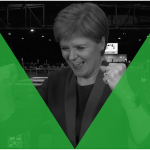
Dr Fiona McKay
Lecturer in Journalism at Robert Gordon University in Aberdeen. Her research explores the intersection between gender, media and political representations, with a particular focus on the Scottish context.
Email: f.mckay5@rgu.ac.uk

Section 3: The Nations
Mirroring the contest throughout the UK, the campaign in Scotland was a decidedly flat affair in terms of women’s participation, sitting in stark contrast to the invigorating civic and grassroots activism which accompanied the Scottish independence referendum and the 2015 and 2017 General Elections. As commentator Kirsty Strickland suggested, this time there was a “focus on bros … an election of the men, by the men”. Even the record number of 220 women elected as MPs across the UK – up from 208 in 2017 – didn’t gather the celebration it may have warranted, representing just 34% of MPs overall. In Scotland, the figures were down. With only 18 female MPs elected, it decreased their ratio from 34% in 2017 to 31%. Engender, Scotland’s feminist organisation, argued that there were hardly any proposals from any party focusing on a vision of the future for women in this year’s so-called “Brexit election”. This was particularly concerning, it said, “given that EU-membership has been instrumental in progressing women’s equality in the UK, driving the expansion of gender mainstreaming into UK and Scottish policy”. Indeed, the feeling was that gender was very much off the agenda in Scotland as the dividing lines were split across the intersection of Brexit and independence.
That was, of course, until the latter period of the campaign when it became a tale of two women, albeit in different governmental realms. From “the most dangerous woman in Britain” to “the bravest woman in politics” (according to Willie Rennie), the election experiences of Nicola Sturgeon and Jo Swinson couldn’t be more different. Though not standing as a candidate, Sturgeon was at the forefront of electoral coverage, while Swinson faced scrutiny in her short-lived role as Liberal Democrat leader. Ultimately losing her East Dunbartonshire seat to the SNP’s Amy Callaghan, discussions focused on her race to the bottom. While many argued her stance on unequivocally revoking article 50 was her downfall, anecdotally, some East Dunbartonshire constituents felt neglected as she focussed much of her campaign on England. Unavoidable though, was the role everyday sexism had to play in her representation. Though Swinson’s “girly swot” t-shirt worn during a photocall was a take on Boris Johnson’s slur on David Cameron, it acted as unfortunate echoing of some of the pejorative framing of her as “shrill” and a “head girl”, hearkening towards the stereotypes attached to young women who over-step their mark in the masculine realm of political leadership. This played out in the infantilising coverage following the election, with Bill Leckie of the Scottish Sun saying that “poor wee Jo” had “flown too close to the sun”. If that wasn’t enough, the author claimed, with the “feather duster [she brought to the] knife-fight” she could now use it to keep her house tidy, due to her unemployment.
Scotland has previously attracted praise for the progressive ‘female face’ of leadership in recent years, however this has also drastically shifted in this election. Ruth Davidson, leader of the Scottish Conservatives, stepped down months prior, following Kezia Dugdale’s departure as Scottish Labour leader two years ago. Davidson’s interim replacement of Jackson Carlaw meant there was only one woman, Nicola Sturgeon, in the leadership line-up of the four main parties. Her resignation, Davidson said, came in part over her conflict about Brexit, but also because of the recent birth of her son, fuelling a revival of longstanding patriarchal discourses about the incompatibility of politics and motherhood. Sturgeon, therefore, was the only female leader in the STV and BBC Scotland Leaders’ Debates, alongside Carlaw, Scottish Labour’s Richard Leonard and Willie Rennie, leader of the Scottish Liberal Democrats. Scholarship suggests that women in leadership positions can generate relatively high media capital due to often embodying the news value of “unexpectedness”. Female leaders can therefore give an impression of parity in both institutional and mediated representation when the overall figures reveal otherwise. Arguably, Sturgeon’s high profile means there may be a sense of better female representation in Scotland than there really is: a gendered implication of the UK’s increasingly presidential-style politics over recent election cycles.
Figures show that the gap is narrowing between the UK and Scottish Parliaments, with the current 34% in Westminster challenging the 36% in Holyrood. As Kenny, MacKay and Murtagh have pointed out, when gender parity is taken off the agenda, the progress to equality of representation often does stagnate. As has been the perennial argument of feminist researchers across Scotland, the proportion of elected female MSPs has never surpassed the high point of women’s representation in the Scottish Parliament at 39.5% in 2003. It remains to be seen whether Scotland will continue its upwards trajectory in its own 2021 election – with the UK nipping at its heels – or stay around the same figure. Whatever the numbers show, though, we still have a long way to go.
